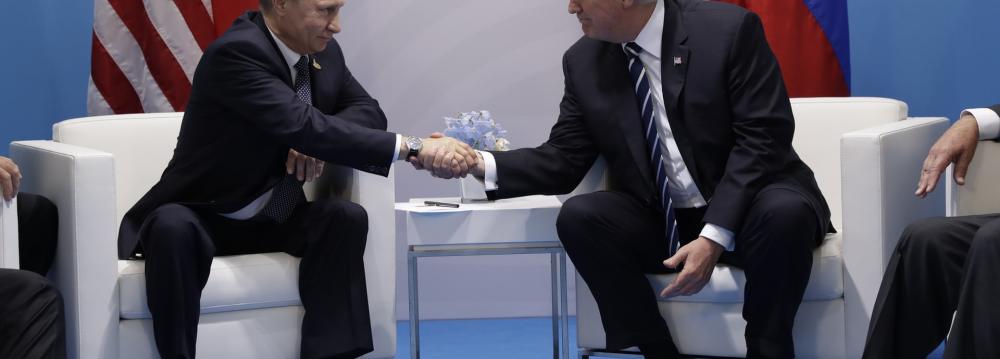The United States and Russia reached an agreement Friday on a ceasefire in southwest Syria, crowning US President Donald Trump’s first meeting with Russian President Vladimir Putin. It is the first US-Russian effort under Trump’s presidency to stem Syria’s six-year civil war.
The ceasefire goes into effect Sunday at noon Damascus time, according to US officials and the Jordanian government, which is also involved in the deal, AP reported.
US Secretary of State Rex Tillerson, who accompanied Trump in his meeting with Putin, said the understanding is designed to reduce violence in an area of Syria near Jordan’s border that is critical to the US ally’s security.
It’s a “very complicated part of the Syrian battlefield,” Tillerson told reporters after the US and Russian leaders met for more than two hours on the sidelines of a global summit in Hamburg, Germany.
Of the agreement, he said, “I think this is our first indication of the US and Russia being able to work together in Syria.”
For years, the former Cold War foes have been backing opposing sides in Syria’s war. Moscow has staunchly backed Syrian President Bashar Assad, supporting Syrian forces militarily since 2015. Washington has backed rebels fighting Assad. Both the US and Russia oppose Islamic State militants and say they’re focused on rooting out the extremist group.
***Potential Pitfalls
Russia Foreign Minister Sergey Lavrov said Russian military police would monitor the new truce. But Tillerson said that was still being worked out. A senior US State Department official said the two countries were close to a deal on that issue and hoped to finalize it in the coming days, raising the prospect it could take effect Sunday with no clear sense of who is policing it.
That the deal was announced before all the details were ironed out was a clear indication of how eager the US and Russia were to cast their leaders’ first meeting as a success. Officials said the deal had been in the works for weeks or months, but came together in time for the meeting.
The deal marks a new level of involvement for the Trump administration in trying to resolve Syria’s civil war.
Jordanian government spokesman Mohammed Momani confirmed the accord in a statement. Syrian government forces and its allies will stay on one side of an agreed demarcation line, and rebel fighters will stick to the other side. The goal is also to enable aid to reach this area of Syria, Momani told state media. US officials said the US, Russia and Jordan had only agreed on that demarcation line last week, clearing the way for a ceasefire to be worked out.
The deal is separate from an agreement that Russia, Turkey and Iran struck earlier this year to try to establish “de-escalation zones” in Syria with reduced bloodshed. The US, wary of Iran’s involvement, stayed away from that effort. Follow-up talks this week in Kazakhstan were unable to produce agreement on finalizing a ceasefire in those zones.
*** Better Prospects for Peace
Tillerson said the difference this time is Russia’s interest in seeing Syria return to stability. It’s an argument top US officials such as former Secretary of State John Kerry cited regularly amid his failed efforts to end a conflict that has killed as many as a half-million people, contributed to Europe’s worst refugee crisis since World War II and allowed IS to emerge as a global terror threat.
Tillerson also repeated the US position that a “long-term role for the Assad family and the Assad regime” is untenable and voiced his belief that Russia might be willing to address the future leadership of Syria, in tones reminiscent of Kerry. Up to now, Assad has rejected any proposals that would see him leave power, contributing to an impasse that has prolonged Syria’s suffering.
Earlier in the week, Syria’s military said it was halting combat operations in the south of Syria for four days, in advance of the new round of Russian-sponsored talks in Kazakhstan. That move covered the southern provinces of Daraa, Quneitra and Sweida. Syria’s government briefly extended that unilateral ceasefire, which was set to expire Saturday — a day before the US and Russian deal was to take effect.


